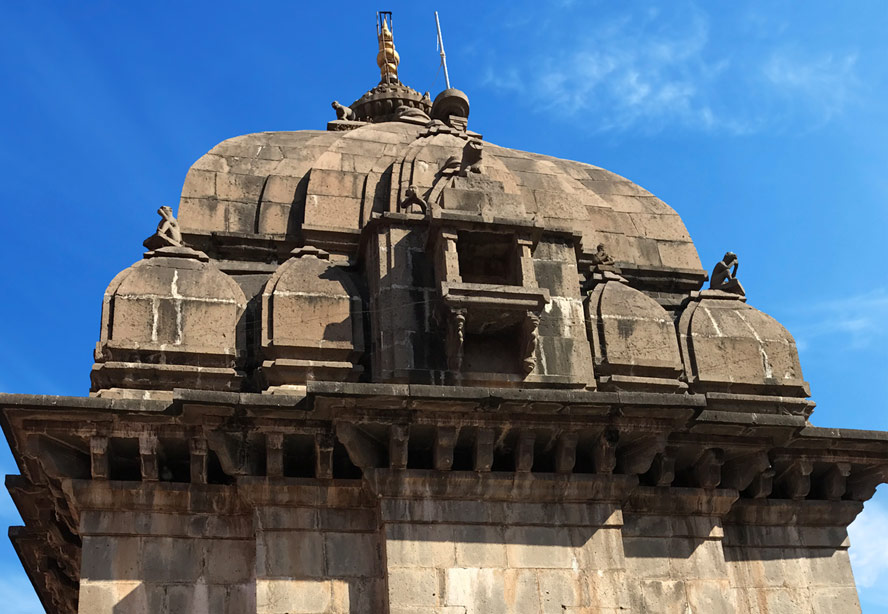
On our way to the Parli tehsil of Aurangabad District of the Marathwada region, we felt that the prince of the sky has hit the streets donning a tie of yellow-white flowers and a suit of sunlight.In the seventh phase of our spiritual journey, Sri Parli Vaidyanath Jyotirlinga Shiv Dham was our next destination, the fifth in the series of 12 sacred jyotirlingas.
On the 212 km long journey from Aurangabad to Parli, on the Parli-Beed NH-82 highway, we were gazing the earth blossoming with the advent of spring, seasonal cotton, saplings of Jwaar-Baajra and lush sugarcane fields. As we were mesmerised by the Vaan river flowing leisurely beneath the Bridge and the reflection of the twinkling sun on the Babool trees, we saw the publicity vehicle of a Tamasha mandli in Majhalgaon.
This style of embellishing the folkflore has been in sight since the Saat Vaahan era. On the occasion of festivals, several such Mandlis coming from Satara, Saangli, Solapur, Kolhapur, and Ahmednagar districts perform skits and traditional dances in other districts of Maharashtra.
It is however, another fact that these mandlis have also been effected with the change of times.
Ahead on the way, the sky touching mountain ranges drew our attention. The geographer from Pune, Abhinav Kurkute informed us about the Harishchandra Range of the area. We were thinking Satyavadi Harishchadra would also have come from Varanasi crossing the mountains like this after obtaining recluse. After which the queen (Shaivayya) Taramati and Son Rohitash would also have come here. Our eyes were now searching for the Rohitashwagarh and Taramatigarh Mountains. Abhinav ji suggested to go towards Ahmednagar for this… anyway…some other time.
The Journey from Aurangabad to Parli
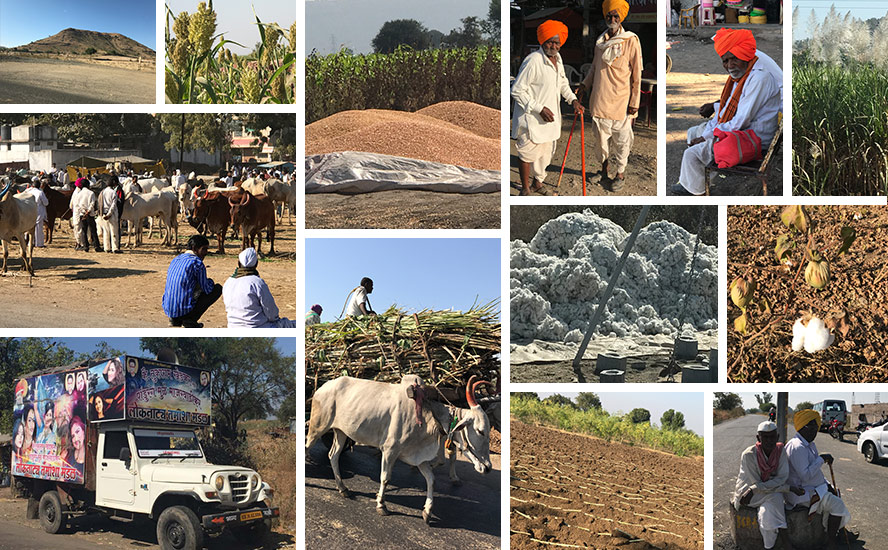
We went ahead thinking about the same. On both the sides of the road, the trees laden with new leaves, tangled in the thorn bushes, peeping from uncountable tampons of cotton, were seeming excited like a child, restless to witness the show of spring. Enquiring about the abundance of cotton in the region from the local farmers, we were told that the soil of the land is black which is good for growing cotton. We thought that this must be the reason two Italian traders Kaziyon and Gustav Ulsi opened around 52 ginning mills in the area in 1890. Not only this, they also started a tradition to donate a part of the profits to the Devsthaan. Overwhelmed by their gesture they were also nominated as general Secretary of the Devsthan Board. The fund is still managed by the Board and is currently funded by the local traders who independently offer 2 percent of their profits for the same.
Viewing the big Chimneys of the Thermal Power Plant, now we had entered the holy place that bestows life’s longevity, the Kaashi of South, “Parli”.
The Mokshadayini Parli- Embellished with Abundance of Shiva
Every throb of the city of Parli, embellished with the abundance of Shiva, is undoubtedly Shivmaya. We entered the east facing Shivalaya from the northern gate of the divine shrine, spread in a sprawling 40 acre land, located on a height of 80 feet in the backdrop of the Balaghat Mountain range, situated in the south west direction from Parli. Here we met Gopal Krishna Raavshaeb Aandhle. The chairperson of cultural committee of the city council of Parli Vaidyanath, Sri Aandhale told us that the importance of Parli is known to be more than that of Kashi by a grain of wheat. This is the reason, people born in Parli are restrained to visit Kashi. Talking about the legendary city of Parli, Sri Aandhle told that there is a belief about the city known as Jayanti in the Krut Yuga, Vaijayanti in the Tretayuga, Kantipuri in the Dwaapar yuga and Parli in the Kalyuga. It is so believed that if a straight line is drawn from Ujjaini, the southern central region of the country, it will come straight to the Meru mountains in Parli. To affirm this claim he told us that Astrologer and Mathematician, Bhaskaracharya (1144-1223) has written two books on astrology named Siddhant Shiromani and Karankutuhal, in which we get the information that Lanka, Kanyakumari, Shail Montains, and Parli’s Meru Mountains are linearly located.
पुरी रक्षसां देव कन्याडथ कांची/सितः पर्वतः पर्यली वत्स गुल्मम्/पूरीचोज्जयिन्याव्हया गर्गराट्म/कुरुक्षेत्र मेरुर्भुवोर्मध्य रेखा
Sri Aandhle continued telling us further about the domains divided in the seven yugas are as per indian time-reckoning. Parli known as Uttam Kshetra in Swayumbhaav, Teertharaj in Swarochish, Narayan kshetra in Uttam, Amriteshwar kshetra in Taamasbrahmashetra Raivat, Ved kshetra in Chakshush, Prabhakar Kshetra in Vaivast is “Jawaaagli Kaashi”.
Bramha, Saraswati and Venumati rivers are known to conflux in the sacred city of Parli, signifying “Paralyam Vaijyanatham”. However the Bramha and Saraswati are now extinct.
Here the Meru mountain is believed to be the home of Vishnu and is considered sacred. This is why it is believed that the way to outworldly virtue is paved from circumambulating the Nagnarayan mountains. As per Sri Andhle, Sri Vishnu dev was sleeping in the Ksheersagar in Yogamudra. The Meru Mountain is also said to be birthplace of the story of Bramhadev originating from his navel and Madhuketabh Daitya from his ear.
The story of people frightened from the mayhem of Madhukaitabya, the demon, calling Yogmata to awaken Sri Vishnu Dev and he killing Madhukaitabhya Daitya by cutting him in three pieces to protect the region is often related to the presence of Hakarya, pukarya and Devkhorya Hillocks.
In the Shivalaya premises only, we met senior pastor Pandit Raja Bhau Digamber Rao Joshi. His six generations have been incessantly serving Sri Devdeveshwar maheshwar with utmost devotion. He revealed an interesting story about Parli. In the Kaantipuri region King Sriyaal and Changuna’s son Chilya was to be coronated, once Sadashiv asked the king for Non-Vegeterian food, the devoted king presented his son’s head to him. Happy with the act, the immortal Shiva fulfilled the king’s desire of being posted in Kailash. However as Parli started towards Kailash to seize the pride of the king proud with the heavenly reward, Neelkanth Shiva inversed it with his legs and thus Padli(Marathi for inverse) or Parli came into being.
To attest his story, Sri Joshi also cites the inverse mud handicraft excavated from the place.
While chatting we had reached infront of Sadashiva, the prime idol of a compassionate character having Knowledge-reclusion and sainthood. As we were standing in the que remembering the omniscience, the ruler of kaal, omnipotent Shiva with a resolute mind, the regional pastor Sri Joshi recited the greatness of the ingenerated Jyotirlinga. According to which around 14 gems originated after the sea churning done by the lords and the Deamons, dhanvantri and amrit kalash were also among them.
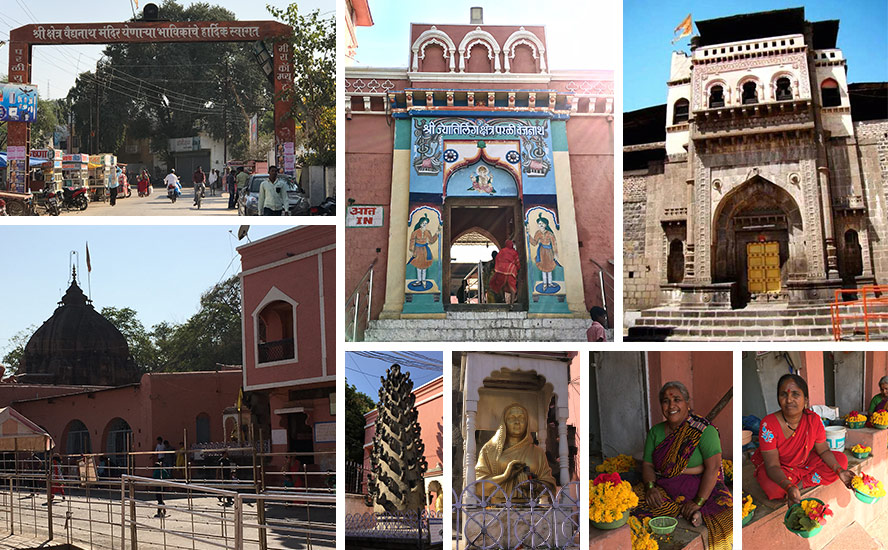
Seeing the competition for both of these getting fierce between gods and the demons, Sri Vishnu Dev hid Dhanvantri and Amrit in the Shivalinga. Fiery flames started coming after the touch of deamons while streams of elixir began flowing after the touch of gods. This is why the Amriteshwar Shivlinga of Mrityunjay Dev got the repute of a Jyotirlinga.
The Vaidyanath Jyotirlinga is worshipped as a salubrious shrine because of the presence of Dhanvantri in the 11 finger high spirited and ingenerated Shaligram Stone. By now we had crossed the interstice and had come down by the stairs. Sri Joshi informed us of all the rule and regulations of the place. The kaakad Arti is performed without opening the door of the shivalaya at 4.30 in the morning. Telling us about the reason of not opening the doors, the regional pastor said that initially this secluded mountainous region was wrapped with insuperable, obscure and bounteous forest reserves, this is why this practice came into being.
After the gates are openbed at around 5 am, the devotees flock the temple. The time till 2 in the noon is reserved for Dugdhabhishek, jalabhishekand panchamrit abhishek of the façade. The Silver façade is removed for an hour for Mekhla Darshan/Nij Darshan and Bilvapatra offerings.
From 3 to 5 in the evening touching the Shivlinga is prohibited however façade darshan is allowed. During this time, Bhasm Puja, Chandan Lepan and Pusp Shringaar is done. The process of darshan and panegyric starts again from 5 to 9.30 in the evening along with offerings of bilwapatra. The shayan aarti is performed amid resonance of Drums at 9.45 in the night, in which the aartis of Sri Vaidyanath, Sri Ganesh and Gauri are sung. “Nandaadeep”, the intact flame (Akhand Jyoti) is ablazed all the time in the GarbhaGrih of Bholenaath, the placable lord of Vishnuites and Shivaaites. Being a Chitabhoomi, the noontime aarti is not performed at the Vaidyanath Jyotirlinga Shivdham. After worshipping the Mrityunjay Dev who is the Lord of three worlds while being the God of the cemetery, unkempt yet a statue of recluse, Potent yet Nirguna, Immutable yet fluctuating, we saw two finger shaped Gaar-Goti, that were symbolicaly resembling the extinct Saraswati river.
Sri Joshi also told us that at the time of low rainfall, water from Harihar Teertha is brought and kept in pots in the Garbhagriha and a similar process is followed in Sri Varuneshwar Temple. More than 100 pandits of the temple, volunteer work together to complete this process.
Although water is abundantly available in the region, digging a well in this region, once known for the Folklore of “Paanyawar Parli” (Parli above the water), one can still easily get water at just 40 feet.
As we came out of the Garbhagriha beholding the dome and the matchless adornments of the temple built in the Heamdpanti style of Yaadav era, we bowed our heads infront of Mata parvati, draped and embellished in Maharashtriyan attire and jewelery.
Gazing at the statue of Mata Parvati outside the GarbhGriha we thought that attaining shiva is impossible without the saadhna of shakti. If Shiva is fire, Uma is Swaha, if Shiva is moon, Uma is a Star, Shiva and Shakti are proven to be of similar dispositions. In words of Saint Gyaneshwar it would be better to say “ Shambhu Tithe Ambika”.
Sri Vaidyanath Jyotirlinga- Worshipped as the salubrious lord because of the presence of Dhanvantri
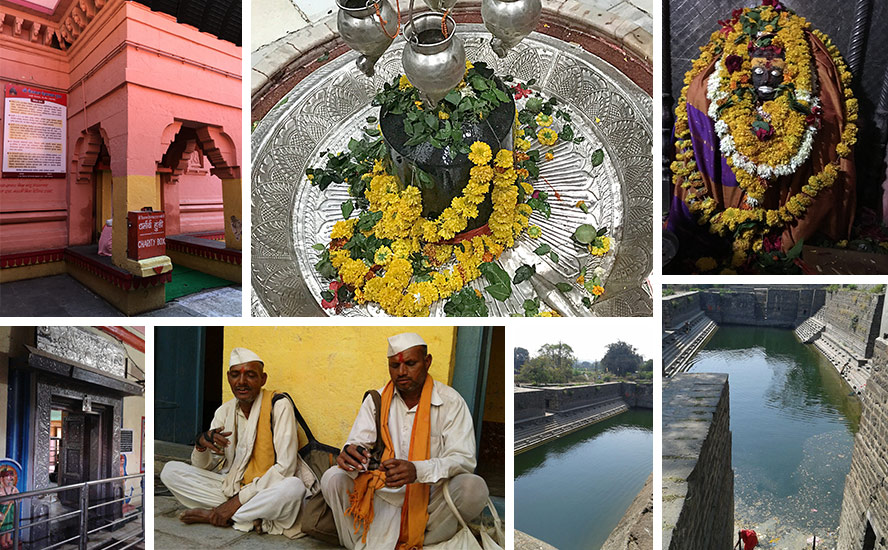
Coming out of the ornated Silver gates we came to the huge hall seeing the tortoise in the interstice. In the middle of which is a 8 feet wide and less heightened stone podium, on which 3 nandis are beseated namely Som, Chaiv and Chand. Sri Joshi told that Som Nandi has been delineated for the morning, Chaiv in the noon and Chand in the evening.
The “Bin Khambi Mandap” made around 1885 by carpenters-blacksmiths with famous Burma rosewood under the supervision of Sri Deshpandey and Sri Deshmukh is remarkable. It has been built by joining strands in a three level style by creating a slot with 1.5-2 feet wide wood. The pavillion has 4 stoned pillars, who appear to be wooden because of their colorful background. Such excellent construction is rare to seen in other Jyotirlinga temples.
Bowing to the huge brass statue of Veerbhadra, we came outside the hall having a shivlinga symbolizing 11 other Jyotirlingas. Here Vaasudevas sitting in the parikrama maarg were singing hymns and playing Manjeeras.
The regional pastor Sri Joshi told us on the way that, there was a time when the tradition of of singing the Ouvi was practiced in all the houses of Parli. In this, the women use to send messages from their maternal homes saying “ganesh bhaiyya hamen liwane k liye nandi ko bhej den, vilamb na karen, pita sri vaidyanath aur mata parvati hamen nahin bisrawe”. We moved ahead inspired by great belief and devotion towards the humungous lord Shiva, Indian culture, life and religion.
The restoration of the Shivalaya by the Holy Queen Ahilyabai
The great queen Ahilyabai endowed the restoration work of the Shivalaya in the Chaitra Shukla of 1706 samvatsar . In the Seven year long resoration work, the Shivalaya was embanked with stone slabs brought from the Trishuladevi mountain located in the northern direction of the Meru Mountain. Though there are three gates in the Shivalaya, but the Eastern and Southern Gates are opened in special circumstances.
There is a giant fretted and brass moulded “Mahaadwaar” placed in the Prachi direction. On Makar sankranti, the sun rays fall on the Jyotirlinga from the window of this gate only. The gate has been made in such a manner that even an elephant can get in easily. Here there are two Ghaats, Poorva Ghaat (Old), Uttar Ghaat (new). On the Poorva Ghaat there is a flagstone naming 1699 Hemlambi and Yadoba Ghond, which shows that the foundation of this work was laid by the then Teerthopadhyaay yadoba Ghond . The Poorva Ghaat is from the yaadav era, while the new ghaat has been built by Queen Ahilya Bai Holkar. As we enquired about the priests (Gurav) and pastors, we came to know that 20-25 homes are of the pastors. Around 400 acres of land was provided in the Nizamshahi era for the 10-12 priest families living here. The land is still the source of income and living for these families.
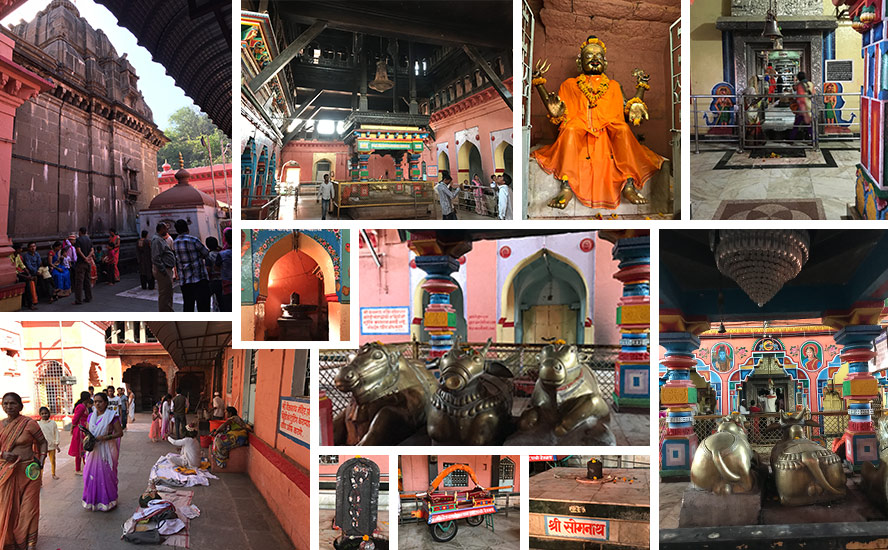
Shivarchana is performed everyday after offering Naivedya to the lord, which includes Pooran Poli from the house of priests decorated in a silver plate and Boondi Laddoos from the trust.
As we came out while chatting, Sri Joshi told us about a 3 Km circumambulating route of the city. In Parli one can see village women in traditional attire, picking and taking flowers.
Coming down from the stairs we came infront of the south facing Ganesha Temple on the Pradakshina maarg.
This place has been associated with the tale of Shankar ji killing Vighnasur and placing his head on the body of Gajanana. It is said that Gajasur entered the womb of sleeping parvati and tried to strangulate Ganesha.
Here Ganesha is beseated like a wrestler, without a trunk. A temple of Markandeya Rishi is also situated on this route, who attained Moksha in a young age and a Ayusha for 16 Yugas with the blessings of Shiva. The tale of Ravana’s son Indrajeet’s ascetism, in the Indreshwar Temple is well known. The Betal Temple of Betal is an awakening place, the origin of which connects to the tale of Betaal Pachhisi.
The land, also known to be the Tapobhumi of Sant Shiromani Jagmitranagaa has abundant Temples and shrines.
It is believed about Jagmitranaga that he brought Vyaaghra alive for the dowry of the daughter of a local Tehsildaar. The footprints of Vyaagrha can still be seen on the Bitthal Tekri.
It is a belief that it was all possible with the blessings of Sri Vaidyanaath. The temples of Batu Bhairav, Amba Aarogya Bhavaani and Sanvalaraam are also worth visiting.
Sri Raam and Sita are beseated in the Vamankaarudh position in the Sanwalaraam Temple. Special activities are organised in the Temple from Chaitra Navraatri to Raam Navami. Bombaliya Ganpati also has ancient significance.
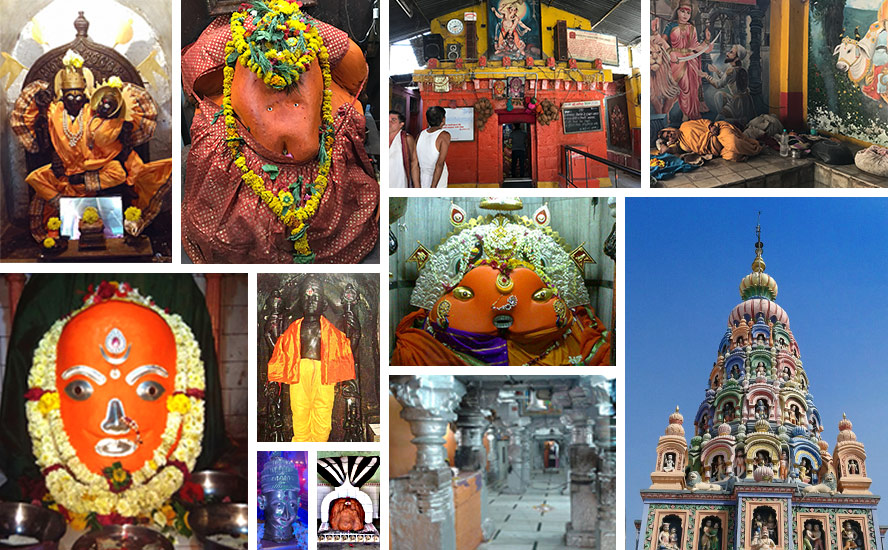
The sacred city of Parli, where even Death is benedictine, has numerous shrine like Jalkunds. The Harihar Teertha has a length of 200 feet and a width of 100 feet. Before circumambulating the Meru, the devotees consider it preferable to take a bath, coming down from the stairs from the west and north. The shrine like water bodies are narayan, Markandey, Amrut Koopi and Chakrateertha Kund. From these the Chakrateertha Kund is often related with the episode of Sri Vishnudev worshipping and pleasing Ashutosh with Sri Shivashastranam Paath and by offering Lotus eyes. Sri Gopinath Temple is also gets a mention in the magnificence of the Parli Harihar region. The temple, situated at around 1 km from the Shivalaya is known as “Jhuralya Gopinath” or the “Temple of Coakroaches”. The place also has proofs of Vishnu a-dusting Asuraas by reincarnating Mohini and the Tapashcharya of Rishi Shatvairvanas, the son of Brahmdev.
In the east of Parli is a temple of Kaalaratri Devi, the sister of Sri Vaidyanath. Even today the tradition of sending clothes to the sister is practiced on Ashwin Navratra. On the border of Parli, a banyan tree related to the incident of Satyavaan and Savitri is worshipped as “Andhanyaavad”.
This religious abode of great saints like Sri Sant Guru Ling Swami, Sant Tulasi raam, Sant Vakeshwar, Sant Poornanand Swami, sant Ghondiraj Swami is also known to be the workplace of the author of “Guru Charitra”, Sri Gangadhar Saraswati.
After saluting the soil of Parli, which provides proximity to Shiva along with divine liberation to the seekers of spiritual advancement, we were left puzzled with the question of “Paralyam Vaijnaatham”.
The compiler of Sri Triyambak region, Sri Kailash Shirvare has also implied this place as a Shivdhaam Jyotirlinga in his book on 12 Jyotirlingas.
A senior reasearcher of the Triyambek region, Sri Rajesh Dikshit also considers Parli Vaijyanatham as a holy place blessed with the presence of Lord Sri Ram, as cited in the episode of Vijay Yatra in the seventh chapter of the 15th century Anand Ramayana having 12 thousand Shlokas.
The Sri Riddhipur Mahatmay Granth , written by Krishnamuni Dimbh in the middle of Shake 1664 also certifies that Paralya vaijyanatham is the same holy place.
The Aadhyagranth “Leelacharitra” written in Marathi, in Shake 1208, i.e. four years before the era of Sant Gyaneshwar, the reference published on the 24 villages located on the banks of Godavari, also mentions the greatness of Parli.
The town of Parli is also glorified in “Leelacharitra Uttarardha”(497,512). Sri Rajesh Dikshit also strongly suggest to follow the great authors and scholars in believing in Parli, located at around 25kms from in the Ishan Direction of Ambajogaai.
He presents his discourse of having a proper research of the ancient relics excavated from the deadland of Ambajogai, the region of the Kuldevi of Konkanasth Brahmins.
Let us tell you that, there is a cave way which connects the Harihar Teertha of Parli to Ambajogai. Here it is believed that Sri Yogeshwari Mata was to be married to Sri Vaidyanath. However, the Muhurat was set off because of the delay caused in adorning the Goddess and all the Baratis got stoned by the anger of Vaidyanath.
Even today, we can hear the sound of utensils by twanging the temple’s pillars. We were thinking that it would be great if, to understand the traits and habits of Shiva like residing in a cemetry, drinking venom, his body language, his migthiness, his omniscience, his independence, we all keep aside all the dissent try to become like Shiva.
Namalgaon Ashapoorak gajanan, the one among the 21 Prime ganpati regions
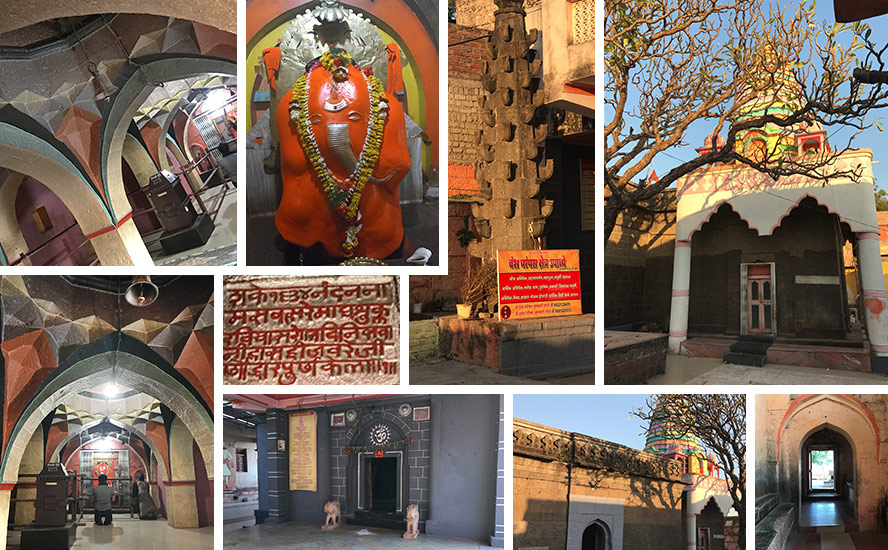
While on our way back, a huge entry gate on the Beed–Aurangabad highway “Naamalgaon Ashapoorak Gajanan”,attracted our attention.
Going 10 km inside the grand ganesha Temple spread in half an acre land, was situated amid impassable tranquility.
The temple situated near the triveni sangam of Karpoora, Naarda and Bindusara rivers is counted among the 21 Prime Ganpati regions. The regional pastor of the temple Pandit Hiremb Sarveshwar Kulkarni/Joshi told us that after taking a dip in the triveni, Dharmaraj Yama performed penace towards Gajanan Ganpati to get liberated from the curse of maternal mortality. As a result, Shiva manifested himself and belssed Yama with the post of Digpal of the Southern direction.
We can see live proof of Tapasvi Bhushundi Yogindra embracing the Mudgal Guru sermons in the Amlakam region.
As we came out of here, the days of spring blended in hues of turmeric and Kumkum looked as if the sun, adorned in saffron, has himself invited everyone to the spring.
The Kailasa Temple of the cave no. 16 of world heritage monument Ellora
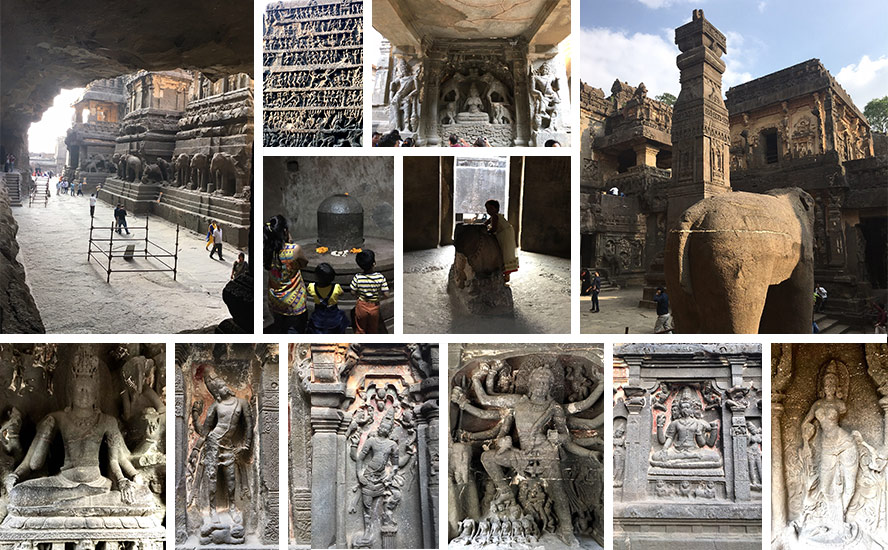
The program to visit the Kailasa Temple of the world heritage site Ellora was made on the way to Aurangabad. We remembered the citation made by senior pastor of Ghrineshwar Jyotirlinga Pandit Rajendra Kaushik, in which he told that the Ghrineshwar Jyotirlinga Temple and the Kailasa Temple(Mankeshwar) at Ellora are linearly located. After reaching here, we saw the eternal features and tranquility of these semicircular heritage statues, spread in a area of 2 kms, showcasing the great, huge and vivid idea of Art in the ancient times. We were astonished to see the heights achieved by the Rock art in the Rashtrakut Clan era in the Seventh century. More than 50 unique dsiplays including Gajalakshmi, Mahayogi Shiva, Mahishasurmardini, Markendya Rishi episode, Killing of Gajasur, Kalarishiva, Killing of Andkasur, Yamuna in Tribhangi posture, Saraswati in Dwibhangi posture, Ganga in Sambhangi Posture were showcasing the greatest patterns of Rock Art. Our guide Pankaj Kaavde and Sri Yogesh Joshi, a conversant of the history of Ellora took us to the second floor to show the Kailasa Temple. Here while seeing the Interstice, Rangmandap, Praakar, Nandi Mandap, Sabhamandap, 16 embellished Pillars and the Devakoshthaka created in Dravidian Style in the light of torch, we worshipped the Shivlinga and got logged in ShivaBhakti. Here we met Crystal Pilz, a Thai resident German woman inspired by the spirituality of Kailasa, who allegorized that Yaksha, Gandharva and Kinnar, who are the protectors of place have rooted here. After which Pilz, subdued by spiritual power devoted herself for the conservation and promotion of this place. While coming out we saw the rock plates depicting a Elephant and several tales of Byaal, Ramayana, Mahabharata with astonished eyes. While leaving behind Ajanta and the mountain ranges of Satpura on our way to Bhopal, we entered the limits of our city, gathering the red flamed flowers of Palaash looking like the Trinetra of Shiva, which often made it to the Tales of our Grandma and remebering the tale of Dhaak ke teen paat.

I am glad to be a visitant of this pure website! , regards for this rare information! .